Much of India’s historic representation comes from stories of partition, colonialism and the Mughal Empire. In terms of culture; it’s a colourful celebration of food, fashion and film. The in-between is rarely explored.
In this world-first exhibition, we’re invited to explore India’s complex political story from three important decades, through the lens of sculpture, paintings, photography, installation and film. The years in focus mark the beginning and end of two pivotal moments in India’s history – the declaration of the State of Emergency by Indira Gandhi in 1975 and the Pokhran Nuclear Tests in 1998. The history is brought to life through vibrant artworks capturing people’s lives during times of tragedy, social change and struggle.
A total of 150 works of art are spread across two floors of the Barbican Art Gallery, some of which are mounted stylishly onto stacked perforated bricks. Though without wall mounted captions explaining the work, the viewer would be lost without the small booklet provided. In Sheba Chhachhi’s photo series, the sturdy faces of seven women activists who fought against dowry-related violence stare back.
They are draped in sarees; their eyes portraying the pain from lost daughters. In Nilima Sheikh’s painting series, we see the true story of a girl who was married off as a child and abused in her in-law’s house is before being murdered. Meanwhile Indian photojournalist Pablo Bartholomew documents the 20 years following the tragi.


















